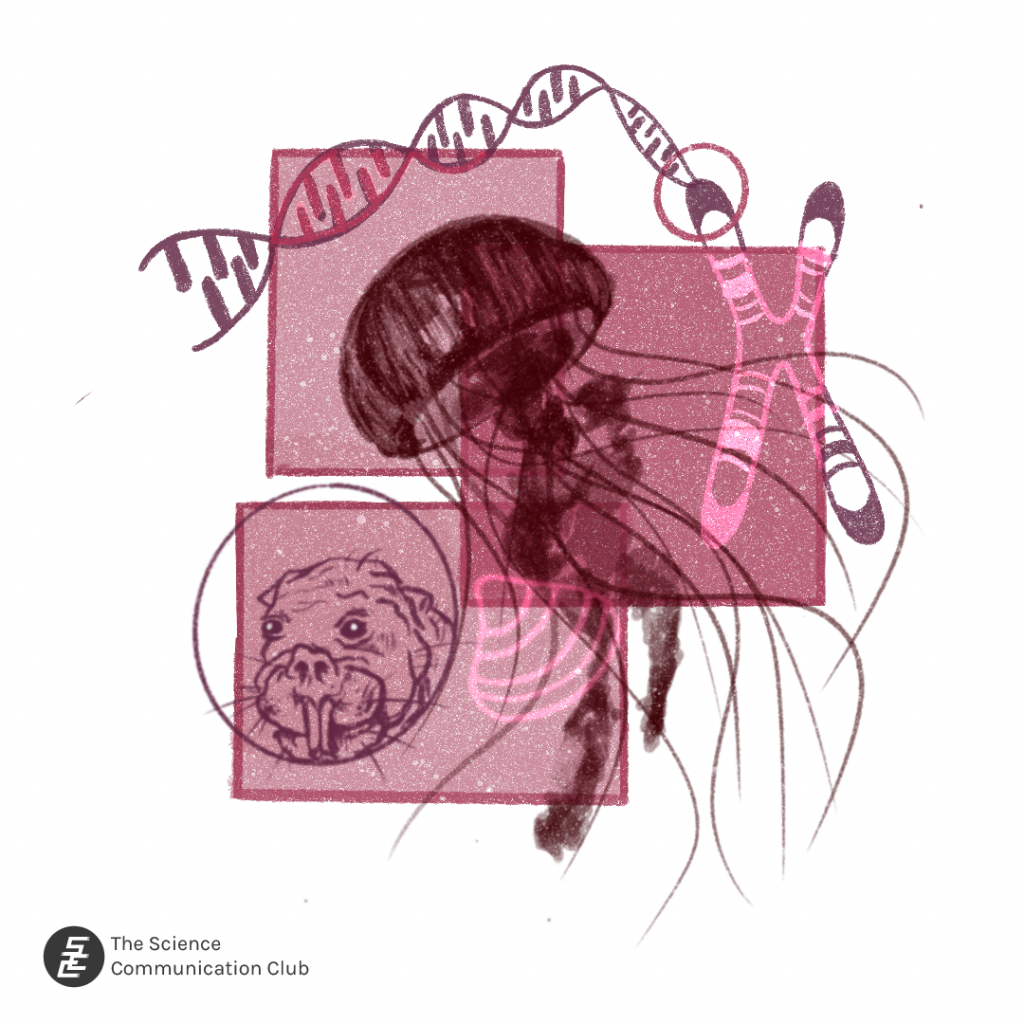
Written by Sabrina Zaidi
Illustrated by Supriya Saha
This article is part of our Special’s Week series, The Science of Science Fiction and Popular Media.
Immortality has always been one of those topics in science fiction that seemed a little too fantastical to ever be true. Maybe it’s not as full of paradoxes as time travel, or riddled with hypothetical questions like extra-terrestrials, but the concept of eternal life has long been seemingly rooted in our primal fear of death. Ever since humans could write, we’ve been fascinated with the preservation of life; from the ancient myths of the Fountain of Youth to the worship of everlasting deities, this fascination has truly stood the tests of time. Now that we finally have the knowledge and technology to potentially make immortality a reality, researchers are looking for ways to bring it out of science fiction and into the real world.
If we ever achieve immortality or prolonged life, humans won’t be the first to do so. There are various animals with exceptionally long life spans, such as the Greenland shark which can live up to around 200-500 years, or the Ocean Quahog clam which can live up to around 500 years.1,2 The longest living animal is the glass sponge, having been thought to be able to live for up to at least a whopping 11,000 years!3 However, only one living species on this planet has ever been considered biologically immortal, and it’s a jellyfish.4 Fittingly named the Immortal Jellyfish, or Turritopsis dohrnii, it defies death by absorbing its tentacles and shrinking itself into a blob that sinks to the bottom of the sea when it experiences damage or physical stress. 4 This rare process is called transdifferentiation, and it’s only possible in species with a specific cell type such as in jellyfish cells. 4 Like with the Immortal Jellyfish, biological mechanisms for extended life are typically relatively specific to the species, giving them notably unique lifespans that are difficult to replicate in other organisms.
Despite not being the greatest at longevity, humans still have pretty long lifespans, with a global life expectancy of around 71-76 years.5 Through perfect body maintenance, we can live up to 125 years old, and researchers believe that the absolute oldest age we can ever achieve is 150.6 Despite this old age, we wouldn’t exactly be in good shape by then, having been deteriorated by aging conditions like joint pain, hearing loss, heart disease, and dementia.7 Once we reach ages 120-150, the body will die as it is no longer able to recover from any illnesses or injuries. However, given the existence of animals with lifespans of over 200 years and even supposed immortality, researchers have begun to realize the attainability of life extension to combat biological aging.

Various life-extension methods are being explored, including preventing cells from aging, or injecting elderly people with young people’s blood.8 A popular theory surrounding telomere lengthening is being investigated by Sierra Sciences, one of the many biotechnology companies seeking to cure aging.8 Telomeres are “caps” at the ends of DNA strands which shorten whenever a cell makes a copy of itself.8 As we age, the telomeres get shorter and shorter until cells can no longer regenerate and the body declines in condition.8 Sierra Sciences aims to revert the body to the biological age of 25 by lengthening our telomeres back to their original state from birth.8 Another company, BioViva, has been examining the same mechanism and performed telomere therapy on their own CEO, Elizabeth Parish, in 2015.8 Since then, she has successfully reported around a five-year decrease in biological age every year.8 Researchers from Harvard are additionally studying indefinite life extension on rodents, having found a way to reverse aging by modifying their DNA structure.9 Another rodent study from the biotechnology company, Calico, was conducted on naked mole rats – the longest lived rodents.10 They found that naked mole rats do not become more susceptible to age-related mortality over time, meaning that they are considered non-aging mammals.10 This study paved the path for future aging studies to use naked mole rats as an effective model.10
For many people, immortality seems like a dream, but it’s also a curse for others. Being able to stay alive for a long time would be great for experiencing as much of life as possible since you can experience anything you’d want to do, without the obstacles of aging. However, many believe that living over a century of life might simply be too long, especially if eternal life is a possibility. Ethical considerations also come into question with the monetization of anti-aging technology. There is concern that advancements in this field would only benefit wealthy people who can afford the potentially highly expensive treatments for life extension. Despite these concerns, there’s no doubt that advancements in life extension technology are an incredible feat of humankind, and there is still much in store for future research in this field.
Sources
- How long do greenland sharks live? NOAA’s National Ocean Service. 2022 Apr 3 [accessed 2022 Nov 18]. https://oceanservice.noaa.gov/facts/greenland-shark.html
- AnAge entry for Arctica Islandica. Ocean quahog clam (Arctica islandica) longevity, ageing, and life history. 2017 Oct 14 [accessed 2022 Nov 18]. https://genomics.senescence.info/species/entry.php?species=Arctica_islandica
- Jochum KP, Wang X, Vennemann TW, Sinha B, Müller WEG. Siliceous deep-sea sponge monorhaphis chuni: A potential paleoclimate archive in ancient animals. Chemical Geology. 2012;300-301:143–151. doi:10.1016/j.chemgeo.2012.01.009
- Osterloff E. Immortal jellyfish: The secret to cheating death. Natural History Museum. [accessed 2022 Nov 18]. https://www.nhm.ac.uk/discover/immortal-jellyfish-secret-to-cheating-death.html#:~:text=It%20has%20been%20dubbed%20the,as%20a%20blob%2Dlike%20cyst.
- Average life expectancy by country. Worlddata.info. [accessed 2022 Nov 18]. https://www.worlddata.info/life-expectancy.php#:~:text=The%20world%20average%20age%20of,data%20from%20the%20year%202020.
- Pyrkov T, Avchaciov K, Tarkhov A, Menshikov L, Gudkov A, Fedichev P. Longitudinal analysis of blood markers reveals progressive loss of resilience and predicts ultimate human lifespan limit. Nature Communications. 2020. doi:10.21203/rs.3.rs-90381/v1
- Ageing and health. World Health Organization. 2022 Oct 1 [accessed 2022 Nov 18]. https://www.who.int/news-room/fact-sheets/detail/ageing-and-health#:~:text=Common%20conditions%20in%20older%20age,conditions%20at%20the%20same%20time.
- Gabbatt A. Is Silicon Valley’s quest for immortality a fate worse than death? The Guardian. 2019 Feb 23 [accessed 2022 Nov 18]. https://www.theguardian.com/technology/2019/feb/22/silicon-valley-immortality-blood-infusion-gene-therapy
- Lu Y, Brommer B, Tian X, Krishnan A, Meer M, Wang C, Vera DL, Zeng Q, Yu D, Bonkowski MS, et al. Reprogramming to recover youthful epigenetic information and Restore Vision. Nature. 2020;588(7836):124–129. doi:10.1038/s41586-020-2975-4
- Ruby JG, Smith M, Buffenstein R. Naked Mole-rat mortality rates defy Gompertzian laws by not increasing with age. eLife. 2018;7. doi:10.7554/elife.31157